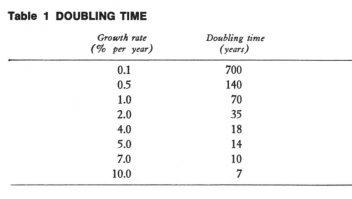The entire 211 page book is online.
There were dozens of model runs in the book.
The Limits to Growth apologists seem to be taking credit for where the model was tuned to match the 1968 UN population projection.
The projections are extremely crude. They are using the exponential factors. So missing by 0.4 instead of 0.5 on an exponential can easily mean being incorrect by a half or a double.
So the Limits to Growth are trumpeting the fact that they tuned one model run to the UN population projection and noted 40 years of business as usual, then they tack on a doomsday scenario. They claim – “see nothing happened for forty years and now doomsday will appear.” Of course when doomsday does not appear they can backtrack to the “timing is not important but it will collapse sometime before 2100”.
The Limits to Growth claim methodology can also be used to justify the Technological Singularity. The World progresses as normal for a few decades and then it becomes completely different.
The Limits to Growth authors do not show an understanding of how resource reserves are calculated based on current prices and based upon how resource companies have to prove and book their reserves for accounting purposes.
The main part of the population projection was where they noted that as per capita wealth increased that family sizes became smaller. Again an observation made by others.
The Limits to Growth had an amusingly inaccurate extrapolation of per capita wealth for each country.
Agricultural yields and productivity have increased
The average world grain yield in 1950 was 1.1 tons per hectare. In 2011, it was 3.3 tons per hectare—a tripling of the 1950 level. Some countries, including the United States and China (about 6 tons per hectare), managed to quadruple grain yields, and all within a human life span.
There are already pilot fields of super-rice that could double yields to 10-13 tons per hectare.
Precision agriculture could double yields by 2030 while reducing the use of fertilizer and water.
Greenhouses can boost yield by six to twenty times over outdoor farming.
If you liked this article, please give it a quick review on ycombinator or StumbleUpon. Thanks

Brian Wang is a Futurist Thought Leader and a popular Science blogger with 1 million readers per month. His blog Nextbigfuture.com is ranked #1 Science News Blog. It covers many disruptive technology and trends including Space, Robotics, Artificial Intelligence, Medicine, Anti-aging Biotechnology, and Nanotechnology.
Known for identifying cutting edge technologies, he is currently a Co-Founder of a startup and fundraiser for high potential early-stage companies. He is the Head of Research for Allocations for deep technology investments and an Angel Investor at Space Angels.
A frequent speaker at corporations, he has been a TEDx speaker, a Singularity University speaker and guest at numerous interviews for radio and podcasts. He is open to public speaking and advising engagements.






